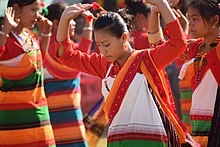
Back ডিমাছা জনগোষ্ঠী Assamese ডিমাসা জনগোষ্ঠী Bengali/Bangla Dimasa Spanish डिमाश जनजाति Hindi திமாசா மக்கள் Tamil
This article needs additional citations for verification. (October 2020) |
This article is written like a personal reflection, personal essay, or argumentative essay that states a Wikipedia editor's personal feelings or presents an original argument about a topic. (September 2020) |
Dimasa | |
|---|---|
 Barman Dimasa girl while performing Baidima, the traditional dance of Dimasa. | |
| Total population | |
| 262,413 (2011 Census) | |
| Regions with significant populations | |
| 142,961 (2011, Dimasa-Kachari,in hill districts of Assam only)[1] | |
| Languages | |
| Dimasa | |
| Religion | |
| Hinduism[2] | |
| Related ethnic groups | |
| Other Bodo–Kachari peoples | |
| Part of a series on the |
| Culture of Assam |
|---|
 |
The Dimasa people (local pronunciation: [dimāsā]) are an ethnolinguistic community presently inhabiting in Assam and Nagaland states in Northeastern India. They speak Dimasa, a Tibeto-Burman language. This community is fairly homogeneous and exclusive, with members required to draw from both parents' separate clans. Dimasa kingdom, one of many early states in Assam following the downfall of Kamarupa kingdom, was established by these people.[6] The Dimasas were till recently agricultural, centering on shifting agriculture; but in recent times this has changed with profound changes in the community.[7] Following political problems in the 18th century, the Dimasa ruler moved further south in the plains of Cachar and there took place a division among them–with the hills Dimasa maintaining their traditional living and political exclusiveness, the plains Dimasas have made no attempt to assert themselves.[8]
Ancient Dimasa tradition maintains that sixty thousand (60,000) Moon months (Lunar months) ago, they left their ancestral land when it suffered a severe drought. After long wandering, they settled at Di-laobra Sangibra, the confluence of the Brahmaputra and Sangi or Di-tsang, where they held a great assembly.[9]
- ^ "ST-14 Scheduled Tribe Population By Religious Community - Assam". census.gov.in. Retrieved 29 February 2020.
- ^ "Census of India Website : Office of the Registrar General & Census Commissioner, India". www.censusindia.gov.in. Retrieved 2 November 2017.
- ^ "639 Identifier Documentation: aho – ISO 639-3". SIL International (formerly known as the Summer Institute of Linguistics). SIL International. Retrieved 29 June 2019.
Ahom [aho]
- ^ "Population by Religious Communities". Census India – 2001. Ministry of Home Affairs, Government of India. Retrieved 1 July 2019.
Census Data Finder/C Series/Population by Religious Communities
- ^ "Population by religion community – 2011". Census of India, 2011. The Registrar General & Census Commissioner, India. Archived from the original on 25 August 2015.
2011census/C-01/DDW00C-01 MDDS.XLS
- ^ "Another local kingdom ... was that of the Dimasas in the north Cachar hills. They were known to the Ahoms as Timisa, clearly a corruption of Dimasa..." (Shin 2020:61)
- ^ (Ramirez 2007:94)
- ^ " Culturally speaking, present-day Cachar Dimasa can hardly be distinguished from the Bengali majority and they seem to make little attempt politically to assert their identity. In the hills, however, Dimasa remained demographically dominant whilst cohabiting with Hmar-Kukis and Zemi Nagas." (Ramirez 2007:93)
- ^ Baruah, Manjeet (29 November 2020), "Buranjis and Sankari Culture: Language and Narrative in Pre-colonial Textual Traditions", Frontier Cultures, Routledge India, pp. 41–75, doi:10.4324/9781003157281-4, ISBN 9781003157281, S2CID 229455719, retrieved 25 November 2021
© MMXXIII Rich X Search. We shall prevail. All rights reserved. Rich X Search